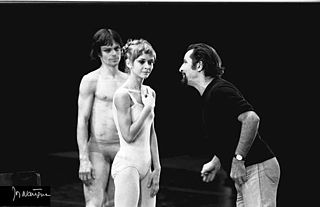Loading AI tools
French-born Swiss ballet dancer and choreographer (1927–2007) From Wikipedia, the free encyclopedia
Maurice Béjart (French: [beʒaʁ]; 1 January 1927 – 22 November 2007) was a French-born dancer, choreographer and opera director who ran the Béjart Ballet Lausanne in Switzerland. He developed a popular expressionistic form of modern ballet, tackling vast themes.[1] He was awarded Swiss citizenship posthumously.
Maurice-Jean Berger was born in Marseille, France, in 1927, the son of French philosopher Gaston Berger. Fascinated by a recital of Serge Lifar, he decided to devote himself entirely to dance. In South France days, he had studied under Mathilde Kschessinska.

In 1945, he enrolled as a corps de ballet at the Opéra de Marseille. From 1946, he had studied under Madam Rousanne Sarkissian, Léo Staats, Madam Lyubov Yegorova and Olga Preobrajenska at "Studio Wacker", etc. in Paris.
In 1948, he also trained with Janine Charrat, Yvette Chauviré and then with Roland Petit, in addition he had studied under Vera Volkova at London.[2][3][4]
In 1954, he founded the Ballet de l'Étoile company (dissolved in 1957). In 1960 he founded the Ballet du XXe Siècle in Brussels (dissolved in 1987).
In 1973, with the Ballet du XXe siecle, he premiered "Golestan", on a poem by Sa'di, based on Iranian traditional music. The ballet was commissioned by the Shiraz-Persepolis Festival of Arts where it was premiered. The first performance of "Improvisation sur Mallarme III" with music by Boulez also took place at that Festival in 1973. "Farah", also based on Iranian traditional music was the Ballet's own commission, premiered in Brussels in 1976 and brought to the Shiraz-Persepolis Festival that same year. The 1976 Festival also witnessed the first performance of "Heliogabalus", based on a poem by Artaud. The Festival's patron was Farah Pahlavi, the former Empress of Iran, with whom Béjart kept strong ties to the end.

In 1987 he moved to Lausanne in Switzerland, where he founded the Béjart Ballet Lausanne.
Among his works is a thoroughly revised version of The Nutcracker, presumably inspired by his own life story, which he staged in 2000. It still uses Tchaikovsky's original score, but completely scraps the original plot and characters, instead supplying a new story about a boy's efforts to re-connect with his mother. We also are given a look into the boy's strange sexual fantasies. The production design is full of erotic images — some of which are most likely shocking to many, such as wombs and vaginal openings. One of the characters is Marius Petipa, who becomes Mephisto. Another character is called Felix the Cat, presumably after the famous cartoon character. The production has been issued on DVD.
One of Béjart's masterpiece works of dance was choreography he set to French composer Maurice Ravel's "Boléro." In The New York Times, Jennifer Dunning described Béjart's "Bolero" as "probably his best known and most popular dance."[5] Created in 1960 for the Yugoslav ballerina Duška Sifnios, the dance features a dancer on a tabletop, surrounded by seated men, who slowly participate in the dance, culminating in a climactic union of the dancers atop the table.[6] Dancers who would later perform Béjart's interpretation of "Bolero" include Sylvie Guillem from the Paris Opera Ballet, Grazia Galante, Maya Plisetskaya, Angele Albrecht, and Roberto Bolle. In a twist, Jorge Donn also played the role of the principal dancer, becoming the first male to do so. One of Donn's such performances can be seen in French filmmaker Claude Lelouch's 1981 musical epic, Les Uns et les Autres.
Béjart was the founder of several dance schools:
During his lifetime, Béjart received many awards and distinctions for his contributions to the arts.[7]
Seamless Wikipedia browsing. On steroids.
Every time you click a link to Wikipedia, Wiktionary or Wikiquote in your browser's search results, it will show the modern Wikiwand interface.
Wikiwand extension is a five stars, simple, with minimum permission required to keep your browsing private, safe and transparent.